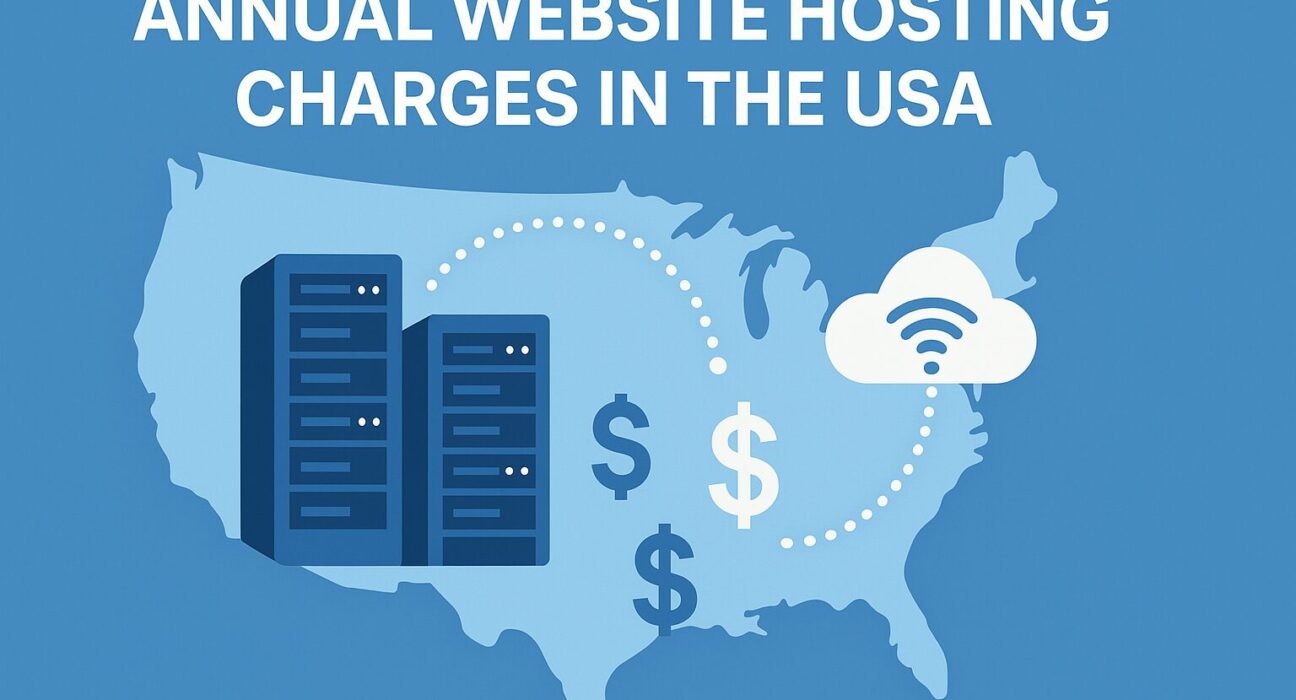Choosing the right web hosting plan is a crucial decision for any individual or business launching a website. In the United States, annual hosting charges can vary widely based on several factors, such as the type of hosting, allocated resources, and additional features offered by providers. This guide will explore the elements that influence hosting costs, examine common hosting types and their typical price ranges, provide an overview of popular hosting providers, and offer tips on balancing cost with quality. By the end, you’ll know what to expect to pay per year for website hosting in the USA and how to make a cost-effective choice.
Table of Contents
- Why Hosting Matters
- Types of Hosting and Price Ranges
- Factors Affecting Annual Costs
- Popular US Hosting Providers
- Tips to Save on Hosting
- Conclusion
- 10 Frequently Asked Questions
Why Hosting Matters
Web hosting provides the server resources needed to store your website files, databases, and applications, making them accessible to visitors. A reliable hosting provider ensures:
- Performance and Speed: Faster load times improve user experience and support SEO efforts.
- Uptime and Reliability: Consistent uptime ensures your site is available around the clock.
- Security: Robust security measures (firewalls, malware scanning, SSL certificates) protect your data and visitors.
- Scalability: The ability to upgrade resources as your traffic grows without experiencing downtime.
- Support: Responsive customer support helps resolve technical issues quickly.
Understanding the different hosting types and their costs will help you choose the most suitable option for your needs.
Types of Hosting and Price Ranges
1. Shared Hosting
Shared hosting is the most budget-friendly option, where multiple websites share the same server resources (CPU, RAM, and bandwidth). It’s ideal for small blogs, portfolios, and new websites with low traffic.
- Typical Annual Cost: $30 – $120 per year
- Resources: Limited storage (10–50 GB), shared CPU/RAM, modest bandwidth
- Pros: Lowest cost, beginner-friendly control panels (cPanel, Plesk), free domain or SSL in many plans
- Cons: Slower performance under high traffic, limited customization, fewer security options
Popular shared hosting providers include Bluehost, HostGator, and SiteGround.
2. VPS (Virtual Private Server) Hosting
VPS hosting allocates a dedicated portion of a physical server to each user, offering more resources and control than shared hosting. It’s well-suited for growing websites, small eCommerce stores, and business sites.
- Typical Annual Cost: $120 – $600 per year
- Resources: Guaranteed RAM (2–8 GB), dedicated CPU cores, scalable storage (50–200 GB SSD), higher bandwidth
- Pros: Improved performance, root access (full server control), better security isolation
- Cons: Higher cost than shared, requires more technical knowledge (unless managed VPS), limited compared to dedicated servers
Notable VPS providers include InMotion Hosting, DreamHost, and Vultr.
3. Dedicated Server Hosting
Dedicated server hosting provides an entire physical server exclusively for your website. This option is best for high-traffic sites, large applications, and enterprises requiring maximum performance.
- Typical Annual Cost: $1,200 – $5,000+ per year
- Resources: Full CPU (4–16 cores), ample RAM (16–64+ GB), large SSD/HDD storage (500 GB – 4+ TB), high bandwidth allocation
- Pros: Maximum performance and reliability, full root access, highly customizable, strong security
- Cons: Highest cost, requires server management expertise (unless managed), overkill for small sites
Providers to consider: Hostwinds, Liquid Web, and Akamai.
4. Cloud Hosting
Cloud hosting distributes your website across multiple virtual servers in a network (“the cloud”). You pay for the resources you use, making it flexible and scalable.
- Typical Annual Cost: $240 – $1,200+ per year (depending on usage)
- Resources: Scalable CPU/RAM/storage, high availability, pay-as-you-go pricing
- Pros: Highly scalable (auto-scaling during traffic spikes), strong uptime (redundant network), custom resource allocation
- Cons: Pricing can be unpredictable if traffic fluctuates, requires some knowledge of cloud infrastructure
Leading cloud providers: Amazon Web Services (AWS), Google Cloud Platform (GCP), Microsoft Azure, and DigitalOcean.
5. Managed WordPress Hosting
Managed WordPress hosting is tailored specifically for WordPress websites. It includes optimized server environments, automatic updates, and enhanced security features.
- Typical Annual Cost: $120 – $600 per year
- Resources: WordPress-optimized servers, automatic backups, staging environments, premium support
- Pros: Hassle-free WordPress management, faster load times, built-in caching, proactive security
- Cons: More expensive than generic shared hosting, limited to WordPress only, fewer customization options on server level
Examples of managed WordPress hosts: WP Engine, SiteGround (WordPress plan), and Kinsta.
Factors Affecting Annual Costs
Several variables influence how much you’ll pay yearly for hosting. Understanding these factors helps you plan and budget effectively:
1. Resource Allocation
- Storage: SSD vs. HDD drives. SSD (solid-state drives) are faster but cost more per GB.
- Bandwidth: Higher traffic sites require more bandwidth. Some providers impose overage fees if you exceed limits.
- CPU & RAM: The number of CPU cores and amount of RAM determine your site’s performance under load.
2. Managed vs. Unmanaged
- Unmanaged: You configure, secure, and update the server yourself. Lower cost but requires technical expertise.
- Managed: The hosting company handles updates, security patches, backups, and optimizations. Higher cost but less hands-on maintenance.
3. SSL Certificates and Security Add-Ons
- Many hosts include a free Let’s Encrypt SSL certificate, but premium SSL (EV or Wildcard) can cost $50–$200 per year.
- Additional security services (malware scanning, DDoS protection, Web Application Firewall) may add $50–$250 annually.
4. Domain Registration and Renewal
- Some hosting plans include a free domain for the first year; renewal typically costs $10–$20 per year.
- If you already own a domain (e.g., example.com), you’ll pay renewal fees separately.
5. Add-On Features
- Automated Backups: $20–$100 per year depending on frequency and storage size.
- Content Delivery Network (CDN): $50–$200 per year for premium CDNs; basic CDN often included in managed plans.
- Email Hosting: Some plans include basic email; premium email services (Microsoft 365, Google Workspace) cost $60–$144 per user per year.
Popular US Hosting Providers
Below is a comparison of several well-known hosting providers, their starting annual costs, and distinguishing features:
| Provider | Starting Annual Cost | Popular Plans | Key Features |
|---|---|---|---|
| Bluehost | $36 | Shared, VPS, Dedicated, Managed WordPress | Free SSL, Free Domain (1 year), 24/7 support, cPanel |
| SiteGround | $47 | Shared, Cloud, Managed WordPress | Daily backups, Free CDN, SuperCacher, Excellent support |
| HostGator | $36 | Shared, VPS, Dedicated, Managed WordPress | 99.9% uptime guarantee, unmetered bandwidth, cPanel |
| WP Engine | $300 | Managed WordPress | Premium performance, free Genesis Framework + StudioPress themes, daily backups |
| DigitalOcean | $120 | Cloud Droplets (VPS), Managed Databases, Kubernetes | Hourly billing, scalable droplets, $100 credit for new users |
| Kinsta | $300 | Managed WordPress (Cloudflare integration) | Google Cloud Platform network, daily backups, free CDN, staging environments |
Tips to Save on Hosting
Here are practical strategies to reduce your annual hosting expenses without sacrificing performance:
1. Opt for Longer Billing Cycles
- Many providers offer significant discounts if you pay for 12, 24, or 36 months upfront instead of month-to-month.
- Example: A shared hosting plan might cost $5/month if billed monthly but $3/month if billed annually or biennially.
2. Choose the Right Hosting Tier
- Avoid overpaying for unused resources. Start on a lower tier (shared or basic VPS) and upgrade as traffic grows.
- Review resource usage periodically and scale back or upgrade based on actual needs.
3. Take Advantage of Promotional Pricing
- Many hosts run promotions for new customers (e.g., 50–70% off for the first term). Be aware of renewal rates, which often revert to standard pricing.
- Use coupon codes and compare multiple providers before committing.
4. Use Free or Bundled Features
- Look for hosts that include free SSL certificates, automatic daily backups, and basic CDN access in their base plans.
- Bundled email hosting or website builders can reduce the need for third-party services.
5. Leverage Open-Source Software
- WordPress, Joomla, and other CMS platforms are free—focus budget on hosting rather than proprietary software licenses.
- Use free plugins and themes whenever possible and upgrade only when specific premium features are required.
6. Audit Resource Usage Regularly
- Monitor bandwidth, CPU, and RAM usage through your hosting control panel. Downgrade or remove add-ons you don’t need.
- Remove inactive websites or subdomains that continue to consume resources.
Conclusion
Annual hosting charges in the USA can range from as low as $30/year for basic shared hosting to over $5,000/year for high-end dedicated servers. By understanding the different hosting types (shared, VPS, dedicated, cloud, and managed WordPress), knowing which factors drive costs (resource allocation, security add-ons, domain renewal), and comparing popular providers, you can make a well-informed decision that aligns with your budget and performance requirements. Always look for promotional offers, bundled features, and scalable plans to optimize costs and avoid overpaying for resources you do not use.
Ready to pick a hosting plan? Bluehost and SiteGround are excellent starting points for reliable, affordable hosting in the USA.
10 Frequently Asked Questions
1. What is the average cost of shared hosting per year in the USA?
The average annual cost for shared hosting in the USA typically ranges from $30 to $120. Most providers offer introductory pricing around $2.95–$5 per month, which renews at $7–$12 per month after the first term.
2. How much does a VPS plan cost per year?
VPS hosting plans generally cost between $120 and $600 per year, depending on the allocated RAM, CPU cores, and storage type (SSD vs. HDD). Managed VPS solutions may cost toward the higher end of this spectrum.
3. Are there any free hosting options available?
Some companies offer limited free hosting plans (e.g., InfinityFree, 000WebHost), but these often come with strict resource limits, forced ads, and unreliable uptime. For professional websites, investing in a paid plan is highly recommended.
4. Should I choose managed WordPress hosting or regular shared hosting?
If you run a WordPress site and prefer hands-off maintenance (automatic updates, daily backups, optimized performance), managed WordPress hosting (typically $120–$600 per year) is worth the extra cost. For very basic WordPress blogs with low traffic, shared hosting may suffice.
5. What factors should I consider when comparing hosting prices?
Key factors include:
- Allocated resources (CPU, RAM, storage, bandwidth)
- Security features (SSL certificates, malware scanning, DDoS protection)
- Backup frequency and retention
- Customer support quality (24/7 live chat, phone support)
- Scalability (ease of upgrading/downgrading plans)
6. How much does cloud hosting cost annually?
Cloud hosting typically costs between $240 and $1,200+ per year. The pay-as-you-go model means your final cost depends on compute hours, bandwidth usage, and additional services (databases, load balancers).
7. Can I save money by choosing a non-US hosting provider?
Non-US providers (e.g., in Europe or Asia) can sometimes offer lower prices. However, if your target audience is primarily in the USA, choosing a US-based data center reduces latency and improves page load times. Balance cost savings with performance considerations.
8. Do I need to pay separately for a domain name?
Many hosts include a free domain registration for the first year (worth $10–$20). After that, you’ll pay a renewal fee (around $10–$20 per year). If you have an existing domain, you’ll only pay the renewal fee directly to the registrar.
9. What additional costs should I expect besides the base hosting fee?
Additional costs may include:
- SSL certificate upgrades (EV/Wildcard): $50–$200 per year
- Premium security add-ons (malware scanning, WAF): $50–$250 per year
- Automated backup services: $20–$100 per year
- CDN (premium): $50–$200 per year
- Email hosting (Google Workspace, Microsoft 365): $60–$144 per user per year
10. Which hosting provider offers the best value for money?
“Best value” depends on your specific needs:
- Beginners/Small Blogs: Bluehost ($36/year starting), user-friendly, free SSL
- Growing Business/eCommerce: SiteGround ($47/year starting), reliable support, daily backups
- WordPress-Focused: WP Engine ($300/year starting), premium performance, staging
- High Scalability: DigitalOcean ($120/year starting), pay as you go, developer-friendly
Evaluate your traffic projections, technical requirements, and budget to determine which host offers the best combination of price and features for your site.




